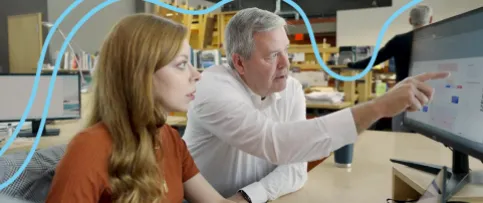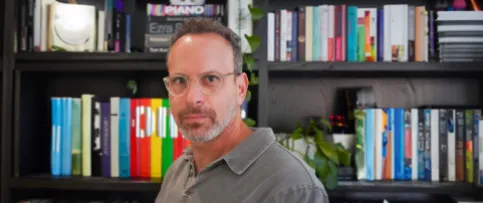Recently licensed architect Vincenzo Stanzione Cubas shares his day-to-day routine at work, the roadblocks he faced while on the path to licensure, and motivating advice for future candidates.
What are your earliest memories of architecture?
My first real encounter with architecture was in middle school. In Venezuela, where I was born and lived until I was 17, we were required to take a drawing class. One of the assignments was to draw a floor plan of a house, and then to make an axonometric view of the simple floor plan. I loved every bit of it and felt like I excelled! It was the first time I had really connected with a class. After this experience, I remember convincing my parents to buy me one of those “make your dream house” computer programs. From that point on, I knew I wanted to become an architect.
But my admiration for architecture began at an even earlier age. My parents loved to travel and that exposed me to new places—each with unique and different types of buildings. Without even knowing then, I began to understand how architecture built identities for cities and countries.
What does your day-to-day job look like?
I don’t have a specific work setting, as I constantly work in different studios where I spend most of my time involved in the construction documents phase. That being said, a working project relies on the understanding and successful application of codes, and that’s exactly what I do every day—building code research. A couple of weeks ago, we were having a discussion in the office regarding an acceptable door projection into the required width of a stair landing. My team gathered around the building code and were able to figure out the situation—a learning experience for us all.
A big part of my day is spent drawing and coordinating with other disciplines. For instance, our team was recently tasked by the city to update the roof of one of our buildings. As part of this project, I’ve gotten to work with one of the lead designers from the office to come up with a new roof design that would deliver exactly what the city wants, while efficiently housing everything we need. Since then, we’ve been in constant contact with the structural engineer, as the columns will be affected by any changes.
As an architect, I think some of our biggest tasks are figuring out what puzzle pieces we have, which ones we need, and most importantly, how to make them all fit together. Drawing a pretty building means nothing if it doesn’t follow the code. In other words, if it’s not structurally stable, we can’t design our “great” ideas with disregard to everything else. Because of this, we architects need our designs to be feasible, efficient, and aesthetically pleasing.
You’ve been with Cohen Freedman Encinosa & Associates Architects since 2012. How did they support you on the path to licensure?
The firm has been great to me and other coworkers on our path to licensure. I actually began studying for the exams with a group of coworkers. We were given access to the conference room and office tools for after-work and weekend study group meetings.
Since I work at a relatively small office, everyone would keep tabs on our progress and on the subjects we were tackling that week. Sometimes our study topics would spark office-wide discussions, which helped further our knowledge. Another great perk was that they gave us off for exam days. I took most of the exams in the mornings, so it was nice to have the rest of the day as a mental break.
Were there any struggles you faced while on the path to licensure, and how did you overcome them?
My biggest struggle was getting into a study mindset after failing one of the exams. I was devastated and for a brief moment, it felt pointless to go back and re-read pages of text I had already read for what seemed like a million times. I decided to give myself a break for a few months before starting to study again. It was what I felt I needed.
When I finally started to go through my study material again, things started to “click” in my mind. Concepts I was previously unsure about suddenly seemed obvious, and everything started to make sense. Toward the end of my exams, I felt sort of disappointed I had not begun studying sooner, but a long break was just what I needed at the time.
Tell us how you collaborate with others in the AEC field.
My place of work specializes in mid-rise and high-rise residential buildings, so we are heavily dependent on other disciplines to make our projects a reality. We are in contact with engineers on a daily basis, sharing not only drawings, but knowledge.
Usually during the construction documents phase, we meet every other week to tackle any outstanding issues. During the construction phase, meetings are held weekly, as construction is more time sensitive.
For me, meeting with other disciplines is a learning experience. On my last meeting with mechanical, electrical, and plumbing (MEP) and structural engineers, we realized there was a conflict between tie columns and exhaust vents. We had to come together and reroute the vents to a location that worked with the tie columns and our window locations.
I believe it’s important for architects to respect and maintain good relationships with people from other disciplines because they serve as the backbone of our buildings. They are the ones helping us make our designs a reality.
Why was earning a license important to you?
Getting my license felt like a culmination of everything that I had studied for—all of the hours and dedication invested into architecture were finally validated. I set out to become an architect in my early teens, and the exams were just another step before reaching that goal. I also wanted to get licensed in order to further my education and knowledge about architecture, eventually becoming a bigger asset to my firm.
What advice do you have for licensure candidates?
What I found that worked for me was having a study plan, and most importantly, sticking to it. For the majority of the exams, I gave myself a three-month timeline. I would study for one hour, Monday through Thursday, take Friday off, then study between three to four hours a day during the weekend. I would do this for a few weeks, but as the date of the exam got closer, I would slowly increase the study hours every other day. I always made sure that I was not burning myself out, which can make it harder to retain information. The last two weeks before the tests were the most intense, and my social life had to wait while I gave priority to the exams.
I also found a lot of great online resources, such as NCARB's website—a must for everyone taking the exams. You’ll want to familiarize yourself with the site, not only with the practice exams, but also with the online videos and tip-sharing blog articles.
I think the most important advice I could give is to take your time while studying—really understand the concepts and why things are done a specific way. It is easier to recall and apply something you understand than something you memorized. We all have to realize that we are not just studying to pass these exams—the knowledge we gain throughout the licensure process will apply to the rest of our careers.



